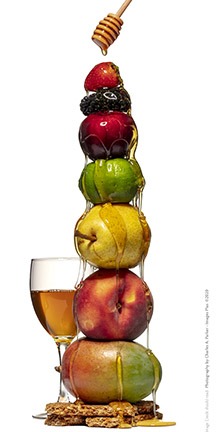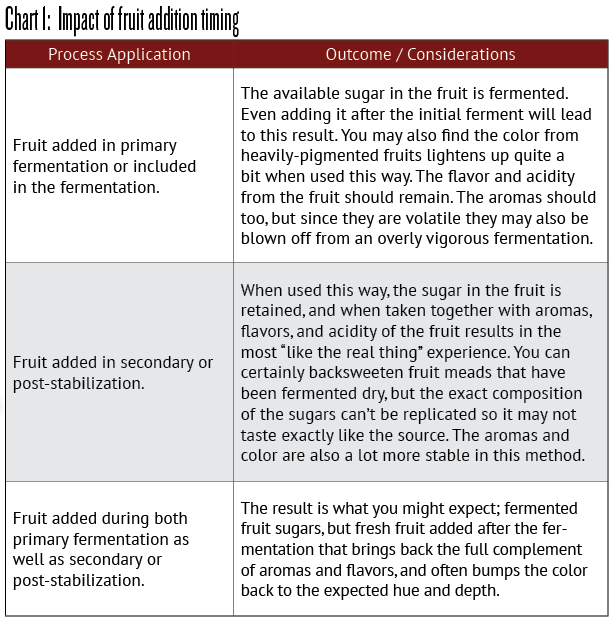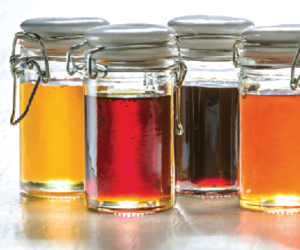
Meads containing fruit are a perpetually hot topic amongst home meadmakers as well as being a huge part of the commercial mead conversation. Taking what we know about making mead from just honey and then adding fruit doesn’t seem to be all that complex of a leap, but I assure you that the adventure of smashing fruit and honey together is way more interesting than just saying, “I made fruit mead!”
Making mead with fruit is a creative journey. What fruits and combinations you use, where and when you use them in the process, and what attributes of the fruit you work to express are all creative choices. Unlocking the secrets of all these different choices is the key to being able to mix them up to create your own hits.
As with any adventure, it is best to jump right in!
Creativity Abounds
At Ancient Fire Mead & Cider (where I’m the Owner/Meadmaker) in Manchester, New Hampshire, we produce three different product lines, including draft style meads, draft ciders, and honey wines. We use fruit in a number of different ways in all of these products. We are constantly dreaming up new combinations and innovative ways to layer fruit, honey, and other ingredients to make delicious new beverages.
This adventure is also based on a whole bunch of questions. Here are some I get from meadmakers all the time: What kinds of fruit should I use? Should I combine different fruits? How do I handle and prepare whole fruit? How do I integrate fruit into my process? Are juices and concentrates good to use, and if so, how? Are there specific fruit combinations that work really well together? How about any that don’t? Got any secrets to share?
Let’s take a look at a recipe for an example of using fruit in mead, in this case wine grapes. In the fall of 2018 I acquired Black Muscat grapes from California through Musto Wine Grape Company. We used the grapes to make a 15.5% ABV honey wine named 60% Of The Time (a recipe for a 5-gallon/19-L version of this recipe can be found at the end of this article).
I am a big fan of Muscat grapes, having made wine and mead with them a number of times in the last 15+ years. Despite this, I hadn’t worked with the Black Muscat variant, a dark red grape as opposed to the usual white, pink, or orange-hued grape. Muscat grapes are known for their distinct and pronounced aromatics, and the grapes we got were no slouch in that regard! To balance the expression of the grapes with the honeys we planned to use, wildflower and red bamboo in our case, we decided to perform a short cold soak on the crushed grapes and then press them pre-fermentation. Extraction of color and flavor were the main goals when deciding to perform a cold soak, while also limiting the extraction of tannins. When done at cool temperatures. Prior to the cold soak we introduced pectic enzyme to help break down the fruit for more effective pressing. The result is an orange wine due the skins not being part of the fermentation. Using the grapes in this way, their juice became a specific part of the volume of the initial must and with a gravity reading we could easily estimate how much of the total fermentable sugar they would introduce.
This was a fairly simple example of using fruit in mead. Let’s now take a look at other techniques and tips.
Formats & Processing
Fruit comes in a number of different forms, and all of them have comparable advantages and disadvantages, but from experience there is definitely a format that best fits every project.
Depending on what form you plan to use, you will need to identify any processing requirements and include that in your batch planning. You want fresh and ripe fruit. They should not have any rotten or moldy spots, but cosmetic issues or blemishes are not a problem. In some cases buying the ugly pieces gets a price break at farm stands, and sometimes otherwise good fruit ends up on the discount rack at the grocery store. All you need is good timing! Whole fruit is a great format to work with, but depending on what volume you plan on using, the processing might well be much more effort than you want to commit to. Cutting the tops off of strawberries is easy, but it still takes time to get through even 20–30 pounds (9–14 kg) of berries!

Juices and concentrates are another great source, and because they are liquified they don’t need any special processing. They mix together with honey and water very easily. The quality of concentrates and juices vary, and there are sources of cold-pressed concentrates that are high quality and retain the complete expression of the aromas, flavors, and colors of the source fruit. We use a passion fruit concentrate that is borderline puree, but the concentration allows for small amounts to be used to get incredible flavor and texture. You want to avoid juices containing preservatives (sorbate, benzoate, others). Cold-pressed variants that also need to be stored in the refrigerator generally are not affected by processing like pasteurized products can be. You are still looking for as much of the freshness of ripe fruit as you can get!
Citrus is a great example of fruit that can be freshly juiced for fresh inclusion in projects. Remember, if you are juicing your own citrus don’t throw away the peels. The peel is where some of the most important action is, including the dozens of terpenoids, known colloquially as essential oils, that produce the aromas and flavors we associate with citrus. We want the peel and not the white pith — which is quite bitter, especially for limes. Most citrus meads I make include both fresh peel AND juice, something I feel allows for all the desired attributes to make their way into the final product.

Purees are widely available, and those that are in aseptic packaging are a great choice due to their shelf stability prior to use. I have used purees in my meadmaking, and sometimes still do, but to be honest I don’t prefer the puree format. There is just too much loss involved with most fruit particles that don’t want to settle out into a compact layer at the bottom of a carboy. Small-scale filtration isn’t really a solution here, and most other “neat tricks” involve excess oxidation so I won’t even cover them. One trick I have used successfully is to pour the puree into a large nylon straining bag that will hold the majority of the pulp back, while still imparting flavor and color. This could be done at any point you wished to use the fruit, allowing the majority of the pulp to be removed easily. This isn’t a reason to avoid using purees, but setting some expectations for when you do. There are exceptions — for instance, Amoretti Craft Purees are filtered and super concentrated to avoid the issue of large particles not settling out.
What else is there? Dried fruits. Think raisins, Zante currants, dates, figs, and dehydrated papaya or apricots. All of these can be used to introduce flavor into mead. When using dried fruit, I recommend chopping them up to increase the surface area for contact with the mead.
Adding Fruit To The Process
Now that we’ve covered different formats you can source fruit in, we need to cover some considerations for actually applying it to the process of making mead.
When we talked about juices and concentrates, I indicated that having a liquid form was an advantage to getting your must mixed up. This advantage also extends to being able to estimate and immediately measure the gravity of a must. Other forms of fruit have the sugars locked up inside them, making an initial reading of gravity exclusive of their contribution. Juices and concentrates can be measured up front (commercial products will often state the Brix) so that their contribution can be included in a recipe calculation. This also creates ease in calculating their impact during use in backsweetening as well. The same contribution from whole fruit can be estimated, but you’ll need to know the typical percentage sugar that the fruit contains. The USDA publishes this information so that the “stereotype” percent sugar content for many fruits — in whole or processed forms — can be included as a recipe component. This information can be found at: https://fdc.nal.usda.gov
Working with whole fruit or puree will be messy. Fruit wants to break down, and you want it to, but it quickly makes a mess that even cold crashing might not easily solve. I mentioned the use of nylon straining bags as a “trick” with puree, but realistically you are going to create a puree out of whole fruit with maceration, so on a small scale you can use these bags with your fruit chunks to help contain some of the mess. After removing the bags from a ferment or a post-ferment steep I run what’s left through a small fruit press to ensure I get all the liquid. I have scaled this method up a bit in my commercial operation, but I do want to make it clear, there are limitations to this technique. Moving and pressing larger volumes of fruit-
laden must using typical winery methods and automated equipment is the next stage.
So, you may be wondering at what point(s) you should use fruit in the meadmaking process. At every point!
The topic of when to use fruit in mead is hotly debated, and just to be clear, there is no correct answer. One’s own experience definitely will identify tricks and tips as well as repeatable outcomes from one technique or another, but there is no objective way to understand how a mead was made from just tasting it. We can produce multiple very similar meads with the fruit having been introduced at different points, and while we might be able to tell that there are differences, it would be luck to consistently associate the mead with the process that created it. For more on the impact fruit will generally have depending on when they are added, refer to Chart 1, found below.

Now let’s take a closer look at another recipe I named Leaping Off The Ledge (at the end of this article), and specifically consider how fruit contact time plays a role as well as how acidity needs to be accounted for.
Contact time, the time the fruit is in contact with a fermenting or a post-ferment product, is going to influence how robust the fruit expression is. The amount of fruit (more on this later) is a huge factor in how much fruit character you can expect, but how long the fruit is applied can be used to moderate or direct the outcome. More importantly, managing the contact time ensures that you don’t get an over-expression of a fruit leading to undesired flavors or aromas.
Citrus peels are back! I only steep lemon peels for a few days when I use them, and I typically apply them in after primary fermentation is complete so I can better judge how much influence they’ve imparted. I check the progress of steeping the peels at 24 hour increments until I’ve reached a point that the flavors are developed to the effect I am looking for. This is done to taste, and ultimately training your senses to be able to choose your own “sweet spot” for ingredients you plan to use is another of the exciting experiences on this journey. You can easily steep citrus peels for too long. A bitterness can quickly develop from the pith, and the more pith that makes its way into the steep the more quickly this undesired outcome will evolve. Lime peels get here very quickly, and this is one of the reasons why I don’t typically use them in favor of lime juice.
Leaping Off The Ledge is a product that was in our starting lineup in 2018 and has elicited some of the most interesting responses to any of our products. Using a base of orange blossom honey we add fresh lemon peels, lemon juice, and hops to flavor the mead. The outcome is pretty much dry hopped lemonade. Fans have said it tastes like summer. The hops also need contact time monitoring, so for this mead that topic is extremely important in the finishing steps because you have two ingredients that absolutely can be in contact with mead too long, leaving behind more than you hoped for.
Layering
One of the most exciting aspects to using fruit (as well as spices, hops, etc.) to make mead is layering the ingredients to create interesting outcomes. I love citrus with berries. Strawberry and lemon or blackberry and lime are two specific combinations that really sing. I’d use orange blossom honey with the strawberry and lemon concept, but might use wildflower or raspberry blossom honey with the blackberry and lime idea. Why? The harmony of these different combinations is created by how the differences in each ingredient play with or off of each other. The citrus-laden honey is very complementary to strawberries and lemon, with some of the total citrus expression coming from the honey. Blackberries are a more robust berry and using a honey that has a richer, fruitier character that can stand up to the berries better ensures the honey doesn’t get lost.
You get to choose how your layers interact. Want to create a street fight? Then put together lots of bold ingredients like blackberries, vanilla, maple syrup, and cinnamon. Want to appreciate the subtlety of an ingredient like elderflower? Don’t overpower it with other strong flavors. Try a fruit like pear and a honey that exudes delicate floral notes like an early season wildflower.
The recipe for Granola Bar! (below) layers dried fruit on top of very characterful honey (buckwheat) to create big flavors and big enjoyment!
Going Big — Fruit Bombs
With fruit meads being all the rage right now, the topic of how much fruit you can stuff into a mead is also popular. A mead with an overwhelming amount of fruit is affectionately called a “fruit bomb.” So, what exactly does this mean?
This practice can simply be understood as drastically increasing the amount of fruit, to 6, 8, 10+ pounds per finished gallon (0.7–1.2+ kg/L), and either foregoing any water or using only enough to liquify the honey and mix it with the fruit. With any “extreme” technique there are inevitably challenges and/or considerations. Jamming a massive amount of fruit into a fermentation definitely brings the volume question into consideration. How big exactly is that fermenter you plan to use?
You will also need the ability to pump or “move” that must to a press basket and press out the liquid. Fruit not only takes up quite a bit of volume, but until you get the water freed from it, it is also heavy. Water alone is 8 lbs./gallon (1 kg/L), so it doesn’t take much imagination to understand what can happen next.
Depending on the fruit(s) being used you need to consider how much acidity is going to be contributed by the fruit. For meadmaking, just like winemaking, the pH during fermentation is optimally 3.2 to 3.6, with honey also having enough acid that when mixed together you may find a lower than expected pH. You can buffer this with potassium bicarbonate to help bring the pH up during the fermentation, but the outcome of the ferment will drive the pH slightly lower, so being at or below the bottom of the range at the beginning likely means you will be right back there post-ferment. You may or may not find you wish to adjust the residual sugar to balance the impression of excess acid.
Many fruits also have lots of tannin in them — think blackberries or black currants — and the more of it that sticks around the more it factors in the ultimate balance you have to consider. The presence of wood and fruit tannins can be a huge boost to the complexity of a fruit mead. Aging is an asset in helping the tannins soften and mellow, much like excess alcohol.
Balance is a popular word in the sensory world of wine. When I first began making wine in 2004 I was also learning to appreciate different styles from all over the world. I was naturally curious, but I also knew this education would inform my home winemaking projects. Balance came up a lot, and I gravitated towards a more harmonious view of balance. All the parts needed to fit together in a tight little package just so. Over time as my education has continued I’ve met many more wine, mead, and cidermakers who use contrast and even boldness of individual ingredients in less “harmonious” ways to create really interesting outcomes.
Fruit bomb meads push the fruit forward — all of it. The flavors, acidity, tannins, colors, it all gets magnified. The components should still feel like they belong there but can be forward and even sometimes angular or perpendicular to the other remaining pieces. The outcome still has to taste good, but highlighting something by bringing it very forward has been fun to experiment with. The creativity of the choices adds a lot of potential projects to the meadmaking calendar!
Keep The Adventure Alive
Whether it is boldly overstuffing your meads with blueberries and black currants, trying to tease the most beautiful subtlety out of a small amount of backyard berries, or layering several fruits together to create something new, the possibilities are limitless.
One of the first things I do when I get a new-to-me honey to work with is taste it and start imagining all the possibilities. Fruit is almost always the first thought. Your adventure continues here!
Fruit Mead Recipes
60% Of The Time
(5 gallons/19 L, bottled under cork)
OG = 1.152 FG = 1.028
ABV = 16%
Ingredients
16 lbs. (7.3 kg) wildflower honey
2.5 gallons (9.5 L) 24 °Brix Black Muscat grapes
2 Tbsp. pectic enzyme
Water to 5 gallons (19 L)
20 g Lalvin KV1116 yeast
10 g Fermaid-K
2.5 g di-ammonium phosphate (DAP)
1.67 g potassium metabisulfite
4 g potassium sorbate
Step by step
Prepare the pectic enzyme by mixing with a small amount of 65 °F (18 °C) tap water. Crush the grapes, mix the pectic enzyme mixture with them and perform a two-hour cold soak prior to pressing off the juice. The grape pomace can be discarded.
Combine grape juice, honey, and water to 5 gallons (19 L). Re-hydrate and pitch the yeast. Degas and feed nutrients at 24, 48 and 72 hours. Ferment to target final gravity and stabilize with sorbate and metabisulfite. Rack off sediment. Bottle under cork.
Tips for Success:
The above directions results in an “orange” pyment due to the skins not being part of the ferment. This was a creative choice. Fermenting with the skins will produce a much darker color, but even more of the specific grape character as well.
Leaping Off The Ledge
(5.25–5.5 gallons/20–21 L, keg carbonated)
OG = 1.058 FG = 0.997 FG = 1.010 (after backsweetening)
ABV = 7%
Ingredients
8 lbs. (3.6 kg) orange blossom honey
Water to 5 gallons (19 L)
10 g SafAle US-05 yeast
7.5 g Fermaid-K
2.5 g di-ammonium phosphate (DAP)
1.67 g potassium metabisulfite
4 g potassium sorbate
1.75 oz. (50 g) Citra® hops
3 lemons, peeled and juiced
12 oz. lemon juice
2 lbs. (0.9 kg) orange blossom honey (for backsweetening)
3 quarts (3 L) water
Step by step
Mix the initial honey and water (some hot, the rest cold) to 5 gallons (19 L). Re-hydrate and pitch the yeast. Degas and feed nutrients at 24 and 48 hours. Ferment dry and stabilize with sorbate and metabisulfite. Rack off sediment. Add lemon peels, lemon juice, hops, and honey (diluted with water) a few days before packaging. Rack off peels and hops when transferring to keg or bottles.
Granola Bar!
(5 gallons/19 L, bottled under cork)
OG = 1.131 FG = 1.020
ABV = 14.5%
Ingredients
18 lbs. (8.2 kg) buckwheat honey
Water to 5 gallons (19 L)
20 g Lalvin 71B-1122 yeast
10 g Fermaid-K
2.5 g di-ammonium phosphate (DAP)
1.67 g potassium metabisulfite
4 g potassium sorbate
2.5 lbs. (1.1 kg) dried zante currants/corinthian raisins
Step by step
Mix the initial honey and water (some hot, the rest cold) to 5 gallons (19 L). Re-hydrate and pitch the yeast. Degas and feed nutrients at 24, 48 and 72 hours. Ferment to target final gravity and stabilize with sorbate and metabisulfite. Rack off sediment. Add Zante currants and/or raisins and steep to taste (this will take weeks, in my experience). Rack off currants/raisins prior to bottling (or pull the bag of them if you added in bagged). Bottle under cork.







